

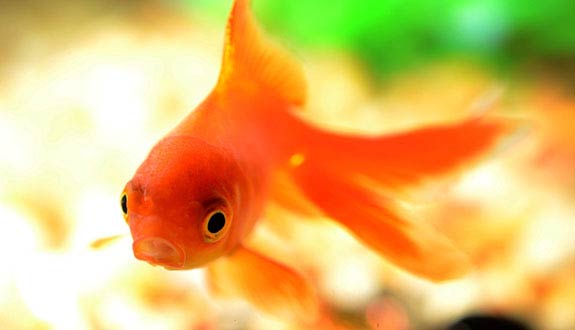
Thanks to Kyllian. As stated by Horlack's scientific article
Alternative species (click on the thumbnail to see the card)
Names
Scientific name
Carassius auratus / chinensis / coeruleus / discolor / pekinensis
Cyprinus auratus / gibelioides / langsdorfii / thoracatus
Leuciscus auratus
Common name
Goldfish
Origin

Origin: China, Vietnam, Mongolia, North Korea, South Korea, Taiwan
Biotope: Asian
Dimorphism

None outside cool perdiods
Group

Cyprinidae
Volume

Common: pond
Varieties: 120 L / 26 imp gal / 32 US gal
Parameters

T°: 5 to 25°C or 41 to 77°F
pH: 6.5 à 8
Hardness: 5 à 25°dGH
Difficulty

Easy
Size

20 to 36 cm (8 to 14")
Longevity

10 to 30 years
Living zone
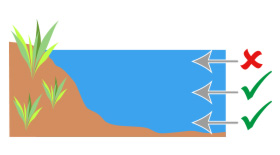
Middle and Depth
Individuals
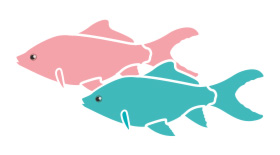
2
Food
How to feed the Goldfish?
Food
How to feed the Goldfish?
Omnivorous: all forms of food are accepted. The basis of its diet will be flakes, granules and flakes from retailers. Fill in occasionally with mudworms, artemia, daphnids (alive or frozen). Also give plant supplements regularly (2 or 3 times a week). For that, boil a few minutes, go to cold water and crush: cucumber, carrot, zucchini, spinach, salad, and their favorite: the pea (without the skin)! Avoid canned peas containing sugar but prefer fresh or frozen vegetables.
Very voracious and insatiable, do not hesitate to dose its meals and distribute them in two times (give only what the fish can eat in 1 or 2 minutes). A goldfish that does not eat is a goldfish that is not well! An occasional fasting is also recommended.
Possible digestive disorders
Be careful that it absorbs food that has already been poured into the water (or sink it yourself). If it feeds daily on the surface, it absorbs a lot of air and this can cause sometimes serious digestive disorders.
Another common problem of this fish is constipation, which is very serious if the problem persists (can even lead to death). This digestive disorder is due to overeating. If your fish is struggling to swim or remains prostrate, it may suffer from constipation. To improve the situation it needs a diet for a few days. If the problem persists, you can give it some castor oil (natural laxative available in pharmacy). To do this, use a pipette and put it directly in the mouth (keep a few moments head slightly out of the water). Not more than one drop a day.
A less stressful alternative is to soak granules in castor oil before giving them to the fish (to be used with a fish that accepts to eat, and that will be temporarily isolated so that it is the sick individual who consumes these granules and not the other occupants of the aquarium). As soon as the fish is better, stop the treatment. One last possibility will be to immerse your fish in an Epsom salt bath. The usual dosages for goldfish are:
- Long bath: 2 to 3 days with 0.2 g/L of salt
- Short bath: 15 to 30 minutes with 5 to 10 g/L of salt.
For the short bath, keep a close watch on your fish: if it shows a behavior of stress (agitation, fast breathing, loss of balance), withdraw it immediately from the bath (source: www.vetofish.com);
Finally, in case of intestinal irritation, you can offer your goldfish a cooked pea and shelled.
Behavior
What kind of behavior does the Goldfish have?
Behavior
What kind of behavior does the Goldfish have?
Very sociable, it is peaceful both with its congeners and with humans. It can however shake a little these roommates at mealtime. Of a rather lively nature, it spends most of its time looking for food. It is likely that it’ll play with its peers and it attaches to them, so do not leave them alone!
Cohabitation
Who can live with the Goldfish?
Cohabitation
Who can live with the Goldfish?
It likes the presence of other Goldfish. It will only blossom fully with the presence of 5 to 6 individuals. This leads to a 400 L (105 gal) volume for 6 medium-sized red fish. Also note that it is recommended not to mix the different varieties of goldfish (a common goldfish can be quite aggressive with a winged fish for example). Goldfish do not have a problem of cohabitation with their congeners. They will be able to associate without difficulty, whatever their sex.
Apart from its own species, it does not live with any fish in an aquarium. It will therefore be necessary to provide a specific aquarium.
In the pond, you can associate it with common river fish such as roach, bleak or chub.
Breeding
How to breed the Goldfish?
Breeding
How to breed the Goldfish?
You will need a good knowledge to succeed in reproducing the goldfish, and it will be easier to make it in the tank than in the aquarium. The goldfish is sexually mature at 2/3 years. The reproduction is triggered rather in cold season (10°C or 50°F). The male pursues the female and hits her. It then deposits oocytes that the male fertilizes thereafter. This operation is repeated several times. Records of spawning yield up to 400,000 eggs for older females. However, in general, laying has about 1000 eggs. Incubation lasts 5/6 days. The fry are greyish and grow in colour as they grow (some sometimes stay gray).
Its aquarium / Pond
Which aquarium/pond for the Goldfish?
Its aquarium / Pond
Which aquarium/pond for the Goldfish?
Why the goldfish has to live in the pond?
Preferably, the common goldfish will be kept in the outer basin. This way of life is much more adapted to its needs! In fact, the goldfish needs large temperature variations over the course of a year. Water needs to go from 15°C or 60°F in winter (or even less, without the water falling below 5°C or 40°F, and it must not freeze) to 28°C or 82°F in the summer so that the growth of the fish be normal. You will then see it stock up on food in the summer and then slow down its metabolism in the winter. It is a completely normal life cycle adapted to the fish's physiognomy (the production of growth hormones is then triggered each year). In these conditions, your fish will be able to reach easily 30 cm or 12 Inches, and live up to 30 years!
If the goldfish lives in a temperate environment like in a home aquarium, the water stagnates all year around 21°C or 70°F, which considerably slows its growth and slows down its development, ending up harming its health. It is estimated that its growth can be divided by 3 under these conditions. It amounts to deliberately dwarfing its fish. It should also be added that below the bar of 20/21°C or 68/70°F, the goldfish slows a lot its activity to prepare for hibernation. If you constantly hold the fish at this temperature, it is in a state of permanent lethargy, and its body is constantly idling. You will notice here that the nanifiction has nothing to do with the volume of the aquarium, but rather with the absence of variations of temperature.
Aquarium maintenance for selected species
However, for the selected forms, some are more fragile than the common goldfish (Oranda, Ryukin, Tail of sail, etc...). They should therefore be kept in a temperate aquarium.
Count a minimum of 120 liters or 30 gallons for a duo, and 50 liters or 13 gallons per additional fish. As a big eater, it's also a big polluter! Powerful filtration will ensure good quality and good oxygenation of the water. Choose a flow filtration at least equal to 5 times the volume of the tray, and preferably external. Also make regular water changes (1/3 of the volume every week). On the other hand, heating is not compulsory (the water must have remained at an average temperature of 20°C or 68°F). Watch out for the plants it will eat without scruple. Opt for very resistant or fast-growing plants such as Elodea, Cerato, Anubias, Vallisneria, Microsorum or Crinum. A fine non-cutting sand will form the substrate because the goldfish often searches the soil.
NO JAR!!!
This practice unfortunately very widespread makes the fish suffer a lot for several reasons:
- Very low volume: it results in a nanification and a difficulty to swim freely: a fish does not swim in circles!
- No temperature change, that is necessary for its growth
- No filtration: the fish constantly lives in a poorly oxygenated water and containing a lot of pollutant. Not to mention that the contact surface between air and water is very limited, which minimizes gas exchange.
- Solitude: the red fish is gregarious and should always have congeners with it for its well-being.
- No planting possible: your friend is deprived of a pleasant decoration.
A jar is a condemnation to a life of suffering and early death. This is why some countries such as Switzerland prohibit this type of maintenance because it is associated with abuse.
Good To know
Find all additional information!
Good To know
Find all additional information!
It is the best-selling fish! And that's normal! It is indeed very resistant, very adaptable, not very demanding concerning its water, lives long and is inexpensive. It will be the ideal companion for beginning aquarists. Be careful though, the qualities of the red fish should not be an excuse for abuse! Like any living being, it has needs that must be respected.
As you can see, by its size, needs and longevity, buying a goldfish is a decision that requires reflection and a long-term commitment.
It is the most studied fish by scientists, with more than 150 000 articles published so far.
Your fish may get "washed out" over time. Indeed, when you buy your young fish, it comes out of a breeding where they add dyes to strengthen its colours. Deprived of these dyes at home, it will lose some of their brilliance over time.
Note that the redfish can hybridize with carp (the alvins will be sterile).
It is found almost everywhere in the wild because many misinformed owners have released their fish (either because it did not want it anymore or because it became too big) in rivers, ponds, lakes, etc... This very resistant fish will adapt very easily to its environment. On the other hand, it causes an imbalance of the ecosystem into which it is introduced. In some places, it is classified as an invasive pest. Marronage (releasing a goldfish in the wild) is prohibited and harmful to the environment.
Many varieties of red fish come from the selection of Carassius auratus. Many of these varieties are fragile and require to be maintained in (large) aquarium (Veiltail, Oranda, Ryukin, Bubble Eyes, Celestial Eyes, etc...).
As for all fish, the "balloon" variety is to be avoided. Indeed, this commercial practice maintains a very cruel malformation (scoliosis) for the fish: metabolic disorders, painful swimming, malformed organs, very high risk of mortality for the female during the birth of the fry, problems during spawning. We encourage you to boycott any kind of fish (regardless of species) so as not to encourage this practice which does little to the quality of life of the animal.
Bubble Eyes and Celestial suffer from many health problems and sight. They are prone to epilepsy. We can only encourage you not to promote the trade of such distorted varieties.
Comète
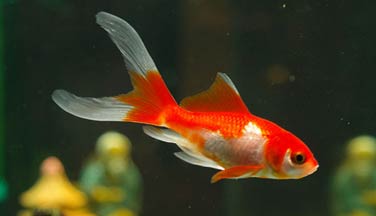
Veiltail
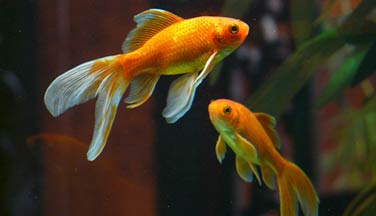
Oranda
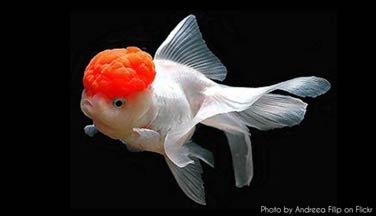
Ranchu
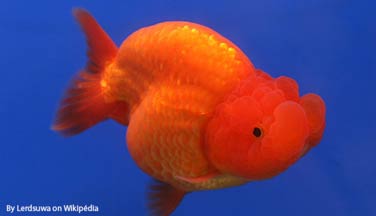
Lionhead
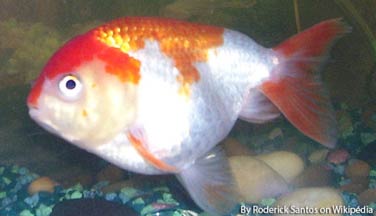
Telescope
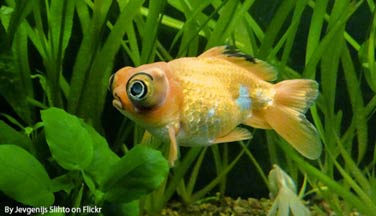
Balloon
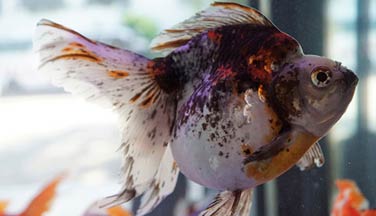
Bubble eyes
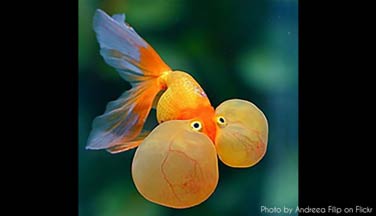
Celestial
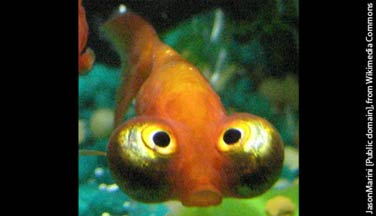
This illutration recapitulates the different possible forms:
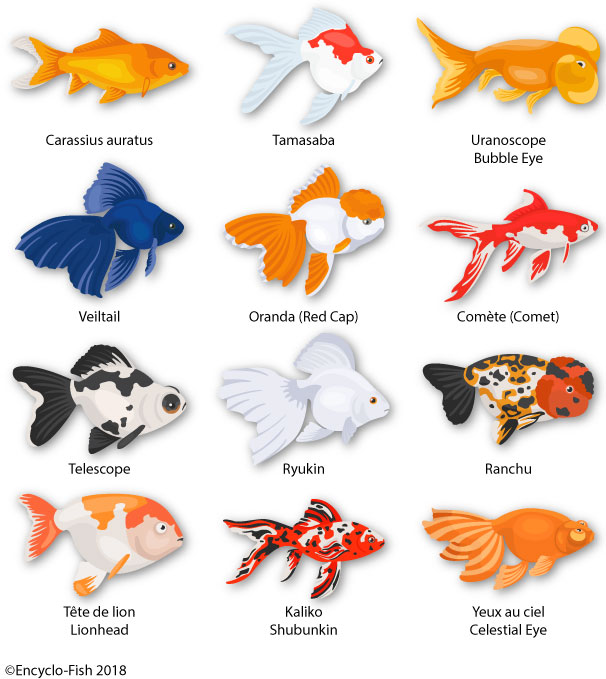
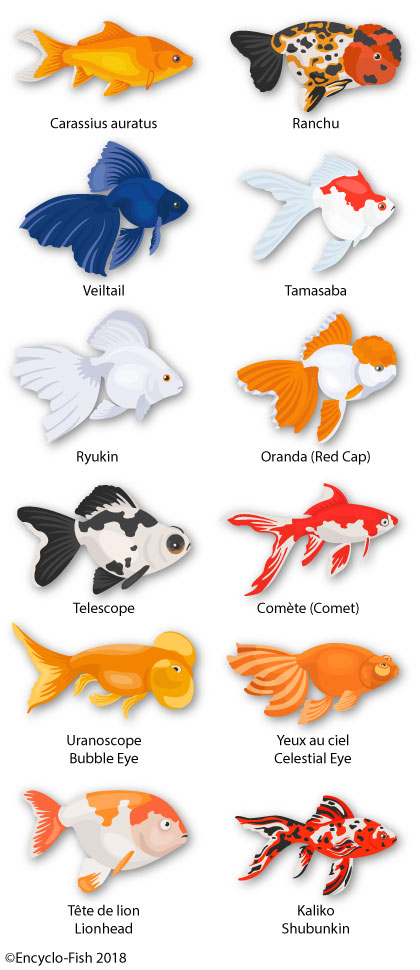
Yours photos!

By Encyclo-Caro

By Encyclo-Caro

By Encyclo-Caro

By Encyclo-Caro
Comments
Sort by:
Please login to post comments
